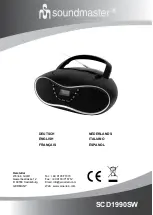
Revision A • 6/06
H
A
R
R
I
S
C
O
R
P
O
R
A T
I
O
N
3-2
3 Using NetWave
CONSOLE DISPLAY
The Reflective Console Display is behind the
control panels. It has two signal level meters (Pro-
gram 1 on the left meter and another source on
the right Aux meter). There is also a time of day
clock and an event timer on the display.
On the NetWave-16 and NetWave-24, an op-
tional display has two additional meters to show
Program 2 and Program 3. The other parts of the
display match the standard display.
A Quick Guide to using the Reflective Console
Display is on page 3-9.
POWER SUPPLY
The NetWave power supply is designed specifi-
cally for 24/7 operation and the console should
not be powered off since doing so will cause com-
plete signal interruption.
The NetWave-24 uses a rack mount supply with
a recessed power switch on the front panel to turn
the supply on/off. If the supply is turned off, wait
at least fifteen seconds before turning the supply
back on.
The NetWave-8 and NetWave-16 consoles come
with an in-line power supply that is typically set
within the cabinetry. This supply does not have a
switch so it must be unplugged from its AC outlet
to turn it off. Again, wait fifteen seconds before
plugging it back in.
VISTAMAX INTEGRATION
When the NetWave console has been tied into a
VistaMax Audio Management System, an almost
unlimited number of audio and audio-with-logic
signals become available to the console. On Dual
Fader channels, a network signal can be assigned
to either the A or B source, with the other source
being assigned to a local input signal. On Dual
Router channels, the source is always a network
signal. The local input can only be used when it is
set as a network source signal during console setup.
A VistaMax system consists of sources (analog
and digital inputs connected to a VistaMax de-
vice) and destinations (an output on a VistaMax
I/O card, a NetWave channel input or External
input). Regardless of where a source is connected
in a VistaMax system, it can be selected and sent
to any number of destinations in the system.
On a Linked NetWave console, this means that
each channel on the console and the two External
inputs are all VistaMax destinations. As such, any
VistaMax source could be routed to these desti-
nations. To make selecting, and identifying, sources
easy on a channel, the Dual Fader is replaced by a
Dual Router panel which allows a board operator
to select sources on those two channels by using
the UP and DWN buttons and the Take button to
find and select a new source.
VistaMax Source Selection
On channels with standard Dual Fader panels,
when a network source is its input, the actual Vis-
taMax source assigned to the channel can’t be
changed on the panel. The source can only be
changed by using a VistaMax Source Selector panel
or by running a session or macro file on the
console’s parent device (this is typically done by
engineering or programming). This may even be
done on a scheduled basis to change routing ac-
cording to daypart. Unfortunately, the source name
is not displayed on the channel. This holds true as
well for a routed External Monitor signal. Typi-
cally routed signals Dual Fader channels and the
external monitor are fixed sources that do not
change.
Dual Router panels have access to changing their
sources and have a 10-character display to show
the source name. Using this panel is covered on
page 3-4.
For a more complete description of the VistaMax
audio management system, refer to the VistaMax
(75-52) or Envoy (75-55) manual.
















































